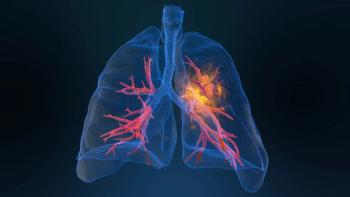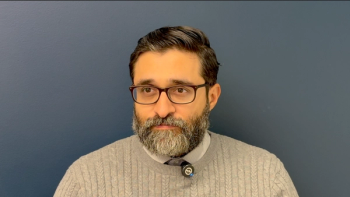
Oncology NEWS International
- Oncology NEWS International Vol 15 No 8
- Volume 15
- Issue 8
Sunitinib and Sorafenib Active in Phase II Advanced NSCLC Trials
Sunitinib (Sutent), which blocks several tumor tyrosine kinase targets, and sorafenib (Nexavar), which targets the tumor Raf/MEK/ERK pathway, are both active in advanced non-small-cell lung cancer (NSCLC), according to phase II studies
ATLANTASunitinib (Sutent), which blocks several tumor tyrosine kinase targets, and sorafenib (Nexavar), which targets the tumor Raf/MEK/ERK pathway, are both active in advanced non-small-cell lung cancer (NSCLC), according to phase II studies, and should be investigated further in earlier stages of the disease and in combination with other targeted agents, researchers said at the American Society of Clinical Oncology 42nd Annual Meeting.
Sunitinib Trial
Sunitinib is an oral tyrosine kinase inhibitor targeting a number of ligands on tumor cells, tumor neovasculature, and tumor pericytes. Mark A. Socinski, MD, of the University of North Carolina, Chapel Hill, reported that in an open-label phase II trial of sunitinib in 63 patients with advanced refractory NSCLC, the drug shrank or stabilized tumors in over 52% of patients (abstract 7001). "This is the first clinical trial to evaluate sunitinib alone in advanced lung cancer patients for whom prior therapy has failed," Dr. Socinski said. "Our findings suggest that sunitinib may have a place in the treatment of lung cancer, alone or in combination with other agents." Sunitinib is a once-daily oral drug that inhibits several kinase enzymes in cancer cells, including vascular endothelial growth factor receptor (VEGFR).
Patients received 50 mg of sunitinib daily for 4 weeks, followed by 2 weeks off. Treatment continued until disease progression. Dr. Socinski reported confirmed partial responses (PRs) in 6 patients (9.5%) and stable disease in another 27 patients (42.9%) (see Table). One patient had an ongoing tumor response at 30.3 weeks.
"The majority of patients had a decrease in the size of the target lesion," Dr. Socinski said. "This is outstanding in such a refractory group of patients."
Most side effects were mild or moderate, most commonly fatigue, nausea, shortness of breath, vomiting, anorexia, or diarrhea. Serious (grade 3-4) side effects included fatigue (27%), shortness of breath (13%), asthenia (9.5%), and nausea/vomiting (10%). There were three deaths, all due to bleeding. Two were pulmonary, and one was a cerebral hemorrhage. Dr. Socinski said that this type of problem might be a class effect with antiangiogenesis drugs. "The therapeutic benefit warrants some risk," he said.
This trial is being extended to explore a continuous dosing strategy of sunitinib at 37.5 mg/d. Dr. Socinski said that the next step for sunitinib will be to move the drug from the refractory setting to first-line use.
Ulrich Gatzemeier, MD, of Hospital Grosshansdorf, Hamburg, Germany, reported data from a phase II trial of single-agent sorafenib in 54 patients with advanced relapsed or refractory NSCLC (abstract 7002). Patients were treated with sorafenib (400 mg twice daily) and were evaluated every 8 weeks.
Of the 51 patients evaluable for efficacy, 31 (59%) had stable disease. Although there were no confirmed PRs, tumor shrinkage was observed in 15 (29%) patients, and four patients had greater than 30% shrinkage. "We saw tumor regression on some patients with borderline PR but decided to characterize it as stable disease," Dr. Gatzemeier said. Four patients had tumor cavitation.
Median progression-free survival (PFS) was 23.7 weeks in stable disease patients and 11.9 weeks in all patients. Median overall survival was 29.3 weeks. Dr. Gatzemeier said that two patients treated for more than 2 years continue to maintain stable disease.
The most common drug toxicities were diarrhea (40%), hand-foot skin (HFS) reaction (37%), fatigue (27%), and nausea (25%). Grade 3 drug toxicities were HFS (10%) and hypertension (4%). Three patients discontinued due to adverse events. Quality-of-life measures showed that physical, social, and family well-being were maintained over the course of study, Dr. Gatzemeier said.
The investigators also examined a number of biomarkers that might help assess the efficacy of sorafenib in NSCLC. "The levels of five proteins measured by ELISA, either at screening or change over treatment duration, correlated significantly with time to progression (TTP) or maximum tumor shrinkage. Levels of five additional proteins, identified by mass-spectrometry, also correlated with TTP," Dr. Gatzemeier reported.
He concluded that "sorafenib 400 mg bid is active and generally well tolerated. The stable disease rate of 59% is comparable to that of other targeted agents in NSCLC. There is a low incidence of bleeding and no deterioration in quality of life during treatment." He said that ongoing phase III trials in advanced NSCLC are testing combined carboplatin/paclitaxel/ sorafenib followed by maintenance sorafenib vs carboplatin/paclitaxel/placebo followed by placebo.
Articles in this issue
over 19 years ago
Younger Age at Brain Tumor Diagnosis Portends Poor Emotional Outcomeover 19 years ago
Triple Targeted Therapy Is Tested in Pts With Solid Tumorsover 19 years ago
FDA Approves Three-Drug Combination Tablet for HIV-1over 19 years ago
Side Effects Persist 16 Years After Prostate Ca Brachytherapyover 19 years ago
No Significant QOL Differences for Raloxifene and Tamoxifenover 19 years ago
Amrubicin Appears Promising in Small-Cell Lung Cancerover 19 years ago
R-MP Active in Older Pts With Newly Diagnosed Myelomaover 19 years ago
Takeda Signs Agreement With Galaxy Biotech for HuL2G7over 19 years ago
Experimental Regimens Fail to Boost Pancreatic SurvivalNewsletter
Stay up to date on recent advances in the multidisciplinary approach to cancer.




















































































